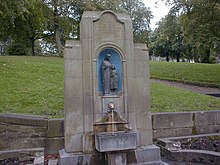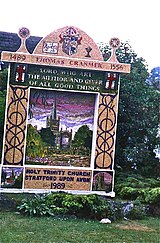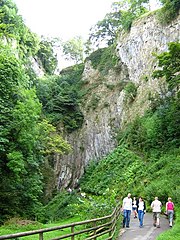| Wonder |
Name |
Location |
Hobbes' verse |
Description |
|---|
 |
St Ann's Well |
Buxton |
"The Sun burnt clouds but glimmer to the fight,
when at famed Buxton’s hot bath we alight
unto St. Ann the Fountain sacred is:
With waters hot and cold its sources rise,
And in its Sulphur-veins there’s medicine lies.
This cures the palsied members of the old,
and cherishes the nerves grown stiff and cold"
|
The natural warm waters of Buxton have been revered since Roman times. By the 1520s the spring was dedicated to St Anne and the curative powers of the waters from the well were reported. A 16th-century act of parliament ruled that a free supply of the spring water must be provided for the town's residents. The current stone water fountain with its brass lion's head spout was built in 1940, replacing its predecessors from 1895, 1783 and earlier. St Ann's well is next to the Pump Room, built in 1894 to dispense the well water for drinking (the building is now the Tourist Information centre). The geothermal spring rises from about 1km below ground and about a million litres of water flow out per day. The mineral water emerges at a steady 27°C. Analysis of the water has indicated that it has a high magnesium content and that it originated around 5,000 years ago. The same spring water is bottled and sold as Buxton Mineral Water.[4][5][6][7] |
 |
The Ebbing and Flowing Well |
Tideswell |
"A thousand paces off, a fount doth rise.
From the low caverns of a grassie hill;
With double mouth its waters gushing still.
Which since the admir'd flux of the greater sea
Doth by report in its small channel play"
|
Thomas Hobbes and Charles Cotton wrote about how this spring would ‘swell and boil up’ and become ‘a little torrent’. However the tidal phenomenon of the ebbing and flowing of this natural siphon stopped after 1790. The well is now largely forgotten and inconspicuous in the front garden of a private house.[8] |
 |
Poole's Cavern |
Buxton |
"One thing remained, but highly worth our view,
Pool's hole, a cave so called and near us too.
Pool was a famous thief, and as we're told
Equal to Cacus, and perchance as old.
Shrowded within this darksome hid retrieve
By spoils of those he robbed, he used to live"
|
This natural limestone cavern is two million years old, formed by underground water dissolving the rock. It has several large chambers (Roman Chamber, Great Dome, Poached Egg Chamber and Sculpture Chamber) with numerous stalactites and stalagmites. Stone Age, Bronze Age and Roman artefacts have been discovered inside. As Hobbes points out, the cavern is named after a medieval outlaw named Poole who used it as a hiding place. A branch of the River Wye flows through the cave system. The cavern is open to the public with tours along its 300m main passage. The temperature is a constant 7°C. Poole's Cavern is part of a designated Site of Special Scientific Interest (SSSI).[9] |
 |
The Devil's Arse (Peak Cavern) |
Castleton |
"A noble Cave between two rocks appears,
Unto the sun unknown, but to the stars
Fearing to be immerged, and both the bears
Turned, it its mouth with horrour does present:
Just like a furnace, or as Hell they paint,
Swallowing with open jawes the damned croud
After the sentence is pronounced aloud."
|
This natural limestone cavern is one of four show caves (open to public visitors) in Castleton. It is situated in a deep gorge below Peveril Castle. The entrance chamber contains the remains of a past settlement where the inhabitants made ropes for the local lead mines for over 400 years.The Great Cave and Roger Rain's House are the two main chambers. The underground stream inside is known as "The Styx" after the mythical River Styx leading to the Underworld of Hades.[10] The cavern has been used as a concert venue by Jarvis Cocker, Richard Hawley and The Vaccines.[11] |
 |
Chatsworth House |
Chatsworth near Bakewell |
"On the English Alps, where Darbies Peak doth rise,
High up in hills, that emulate the skies,
And largely waters all the vales below,
With rivers that still plentifully flow,
Doth Chatsworth by swift Derwins Channel stand"
|
The stately home is the residence of the Duke of Devonshire and has been the Cavendish family's home since 1549. The house was built by Bess of Hardwick (wife of William Cavendish) between 1553 and the 1560s and is a Grade I listed building. The estate on the banks of the River Derwent covers nearly 2,000 acres of gardens, landscaped parkland and woodland. In the 1700s Lancelot "Capability" Brown designed the estate's landscape. In the 1800s Joseph Paxton was the head gardener. The house and park are open to public and attract about 300,000 visitors a year. The house contains major collections of paintings, furniture and sculptures.[12][13] |
 |
Mam Tor |
Castleton |
"Until the mountains top and that be one.
And though the most called Mam Tor, nevertheless
Maimed for the cliff I rather should express.
Which does in English a torn rock denote,
And the decrepit hill gives favour to't."
|
The hill at the end of Rushup Edge is over 500m high with clear views up the Hope Valley and across to Kinder Scout. Its name means Mother Hill. The hill is owned and managed by the National Trust.[14] The south east face is subject to continual landslides and the unstable A625 road across it was permanently closed after 1979 (so that all traffic now goes through Winnats Pass).[15] The updraft winds created by the steep face make the hill a popular location for paragliders. The Bronze Age hillfort and burial mounds are a protected Scheduled Monument.[16] |
 |
Eldon Hole |
Eldon Hill near Castleton |
"This laid the stone
We drop, which circled in thick mist is thrown.
Against a rock, the cavern groans the while,
Loud sighs are vented from the shaken pile.
from rock to rock, the sound goes download still,
Less head by us but the more heard by Hell"
|
This chasm is 245 feet (75 m) deep, making it the deepest pothole in Derbyshire. The entrance at the surface is 115 feet (35 m) long by 20 feet (6.1 m) wide. At the bottom is a cavern with a dome-shaped roof and stalactites. According to folklore the devil lived inside it.[17][18] |







